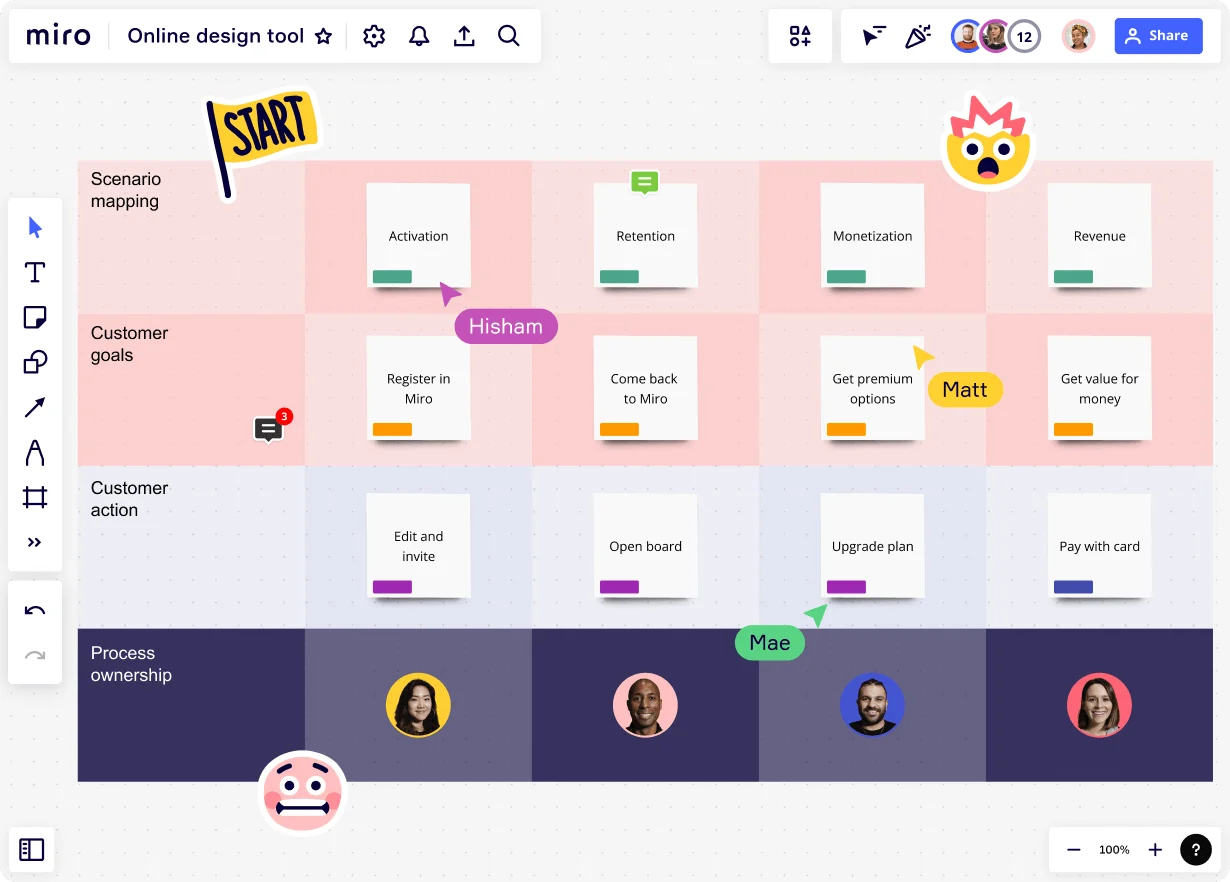
Table of contents
Table of contents
The 5 Design Thinking Steps

Navigating the process: Key Design Thinking steps for success
Design Thinking has become a cornerstone methodology in the design world, revered for its human-centric approach. Whether you're a seasoned professional or new to the game, understanding the design thinking steps will undoubtedly elevate your problem-solving skills. This article delves into these critical steps and offers tips for effectively running design thinking workshops.
Understanding Design Thinking
Design Thinking is a holistic, solution-focused approach to problem-solving that prioritizes empathy and experimentation. Rooted in understanding the user's needs, it leverages creative and critical thinking to deliver innovative solutions. By embracing this process, designers and design management professionals can create user-friendly products that align with both user needs and business goals.
The five fey steps of Design Thinking
The Design Thinking process comprises five key steps—empathize, define, ideate, prototype, and test. It's crucial to remember this is a non-linear process, and designers may oscillate between stages as insights emerge.
Empathize
This first step is a deep dive into understanding the users' needs, context, and challenges. This empathy-building phase lays the groundwork for the entire Design Thinking process.
Empathy helps you step outside of your own perspectives, assumptions, and biases, providing a genuine understanding of your users. Techniques such as direct observations, interviews, or immersion can be employed, as well as building an empathy map. Try Miro's empathy map templates.
When facilitating a workshop, encourage participants to truly listen and keep an open mind. Role-playing can be an effective technique to foster empathy and understand the user's experience.
Define
At this stage, your accumulated observations are synthesized into a clear and actionable problem statement—what Design Thinking refers to as the "Point Of View." This statement should be user-focused and broad enough to allow for creative freedom yet narrow enough to make it manageable.
In a workshop setting, help participants to avoid rushing this phase. Use affinity diagrams to group and categorize findings and then craft problem statements. Keep refining until you have a statement everyone agrees resonates with the user insights.
Ideate
Ideation is all about creativity and expansion. The goal here is to generate a wide range of ideas that might answer the defined problem statement. Encourage wild ideas, defer judgment, and aim for quantity over quality at this stage.
Facilitating ideation in a workshop can be both exciting and challenging. Diverse teams tend to generate diverse ideas, so be prepared to effectively manage and harness this diversity. Techniques like brainstorming, mind mapping, or "worst possible idea" can stimulate creativity.
Prototype
Prototyping is all about bringing ideas to life. It's a stage of experimentation where solutions are created based on the ideas generated. These prototypes are preliminary models of the final product and can range from simple paper sketches to interactive digital models.
In a workshop, emphasize that the prototype doesn't have to be perfect; it's a tool for learning. Provide a range of materials for physical prototyping, and guide teams on using prototyping software for digital products.
Test
Testing is where the rubber meets the road. Here, the prototypes are presented to the users, and their interactions and feedback are observed. This feedback is then used to refine the solution and may even unearth insights that lead you back to previous steps.
In a workshop, role-play can be a great way to test prototypes. Ensure that participants understand the value of constructive feedback and are ready to embrace changes to their prototypes based on the insights gathered.
Implementation of Design Thinking steps
Design Thinking is less about the steps and more about the mindset: curiosity, empathy, embracing ambiguity, and accepting failure
as a path to success. Here are some tips to ensure a smooth process:
Embrace Diversity: A mix of perspectives can provide a broader understanding of the user and stimulate more varied ideas.
Foster a Safe Space: Encourage openness and ensure all ideas are welcomed without judgment.
Encourage Active Listening: Whether interviewing users or receiving feedback from team members, active listening is key to gaining deeper insights.
Iterate, Iterate, Iterate: Don't be afraid to revisit previous steps. Iteration is at the heart of Design Thinking—it's all about learning and improving.
Design Thinking in different industries
Design Thinking isn't exclusive to design-centric fields. Its applicability spans various sectors, from healthcare to education and even government bodies. For instance, Airbnb used Design Thinking to redesign its user experience, leading to a significant increase in bookings. Meanwhile, the UK government used it to restructure its digital services, making them more user-friendly and accessible.
Common misconceptions and challenges in Design Thinking
One common misconception is that Design Thinking is a linear process. Remember, it's not unusual or wrong to circle back to previous steps. Also, don't be disheartened if your first solution isn't the winning one—it's part of the iterative process.
Another challenge is ensuring genuine empathy. Avoid making assumptions and stay true to the user insights you've gathered.
Finally, don't be pressured to race through the steps. The goal of Design Thinking isn't speed—it's finding the right solution.
Conclusion
The transformative power of Design Thinking lies not just in understanding the steps, but in adopting the underlying mindset. It's a methodology that helps us design products, services, processes, and strategies with a human-centric lens. As you navigate your way through empathizing, defining, ideating, prototyping, and testing, remember to stay open, curious, and flexible. And above all, keep your users at the heart of your decision-making.
Embrace Design Thinking—it's more than a process; it's a way to a better, more empathetic, and innovative world.